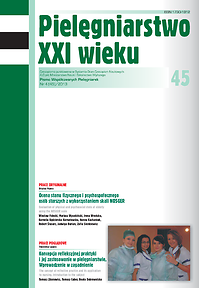Znaczenie i charakterystyka prawidłowego żywienia w okresie niemowlęcym
Słowa kluczowe:
prawidłowe żywienie, niemowlęta, wpływ na rozwójAbstrakt
SIGNIFICANCE AND CHARACTERISTICS OF PROPER NUTRITION IN INFANCY
Introduction. Rational nutrition is the optimal in quantitative and qualitative terms composition of the diet of infants, which is essential to their health and proper development during a critical period of growth and in the later years of life.
Aim. Discussing issues of rational nutrition in infancy.
Materials and methods. Review of the medical literature in terms of characteristics and significance of proper nutrition in infancy for further development of children and youth.
Results. During infancy, there are two fundamentally different methods of feeding - natural and artificial. The physiological way is breastfeeding that provides all the components necessary for the physical development, as well as stimuli that shape social interaction skills. The sequence and time of introducing complementary foods must be closely correlated with the physical and psychomotor development of the child. Selection of artificial nutrition formulas should take into account the digestive possibilities of gastrointestinal tract, the physiological condition of the internal organs of the child and the existing health hazards resulting from genetics. Qualitative and quantitative deficiencies during the enriching of infants’ diets frequently lead to the development of civilization diseases, including allergic diseases.
Conclusions.
- Infants and younger children are the group most vulnerable to the slightest dietary mistakes.
- Monitoring diet in the first years of age is one of the main factors determining good health, mental and motor development of the child, as well as lifestyle in adulthood.
- The transition from breastfeeding to artificial diet is an important event in the life of a child, which affects body metabolism
Bibliografia
1. Jarosz M (red.). Zasady prawidłowego żywienia dzieci i młodzieży oraz wskazówki dotyczące zdrowego stylu życia. Narodowy program zapobiegania nadwadze i otyłości oraz przewlekłym chorobom niezakaźnym poprzez poprawę żywienia i aktywności fizycznej. Warszawa: Wyd. Instytut Żywności i Żywienia; 2008.
2. Czerwionka – Szaflarska M, Adamska I. Żywienie a prawidłowy rozwój dziecka. Klinika Pediatryczna. 2010; 18(2): 209-212.
3. Książyk J. Wybrane zagadnienia dotyczące żywienia dzieci. Medycyna Praktyczna. 2009; 6: 14-18.
4. Dobrzańska A, Czerwonka-Szaflarska M. Zalecenia dotyczące żywienia dzieci zdrowych w wieku od 1 do 3 lat (13-36 miesięcy) opracowane przez zespół ekspertów powołanych przez konsultanta krajowego ds. pediatrii. Przegląd Pediatryczny. 2008; 38(1):76-78.
5. Krawczyński M. (red.). Żywienie dzieci w zdrowiu i chorobie. Kraków: Wyd. I, Wyd. Help Med. 2011.
6. Horvath A, Dziechciarz P. Żywienie dziecka w 1. roku życia. Standardy Medycyny Pediatrycznej. 2010; 7(4): 563-566.
7. Akobeng AK, Ramanan AV, Buchan I et al. Effect of breast feeding on risk of coeliac disease: a systematic review and meta-analysis of observational studies. Arch Dis Child. 2006;91:39-43.
8. Chmielewska A, Szajewska H. Żywienie u niemowląt - aktualne wytyczne. Lekarz. 2012;(2): 20: 22-27.
9. Pokorna-Kałwak D, Muszyńska A, Steciwko A. Żywienie niemowląt i małych dzieci – najnowsze wytyczne prawidłowej diety. Terapia. 2009; 17, 9, (1): 90-94.
10. Socha J, Socha P, Weker H i wsp. Żywienie dzieci a zdrowie wczoraj, dziś i jutro. Pediatria Współczesna. 2010, 12 (1): 34-37.
11. Stolarczyk A, Szott K, Socha P. Ocena sposobu żywienia niemowląt w wieku 6 i 12 m. ż. w populacji polskiej w odniesieniu do zaleceń Schematu Żywienia Niemowląt z 2007r. Standardy Medyczne, Pediatria. 2012, 9 (4): 545-551.
12. Szajewska H, Chmielewska A, Dziechciarz P i wsp. Żywienie niemowląt i małych dzieci. Medycyna Praktyczna. Pediatria, 2011 wyd. spec. 1: 33-37.
13. Weker H, Więch M. Żywność dla niemowląt i małych dzieci w świetle nowych regulacji prawnych, ,,Bromatologia i Chemia Toksykologiczna, XLI. 2008; 3: 883-887.
14. Wesół-Kucharska D. Kalendarz żywienia zdrowych dzieci. Klinika Pediatryczna. 2011; 19(1): 63-65.
15. Wesół-Kucharska D, Książyk J. Wprowadzenie posiłków uzupełniających. Pediatria. Medycyna Rodzinna. 2011;7 (1): 35-40.
16. Funkowicz M, Gawlik H, Jędrzejczyk M i wsp. Wiedza rodziców niemowląt na temat aktualnych zaleceń dotyczących żywienia. Pediatria Współczesna: Gastroenterologia, Hepatologia i Żywienie Dziecka. 2012, 14 (3): 122-126.
17. Carlsson A, Agardh D, Borulf S et al. Prevalence of celiac disease: before and after a national change in feeding recommendations. Scand J Gastroenterol. 2006; 41:553-8.
18. Kull I, Bergstrom A, Lilja G et al. Fish consumption during the first year of life and development of allergic diseases during childhood. Allergy. 2006;Aug (61):1009-15.
19. Zutavern A, Brokow I, Schaaf B et al. Timing of solid food introduction in relation to atopic dermatitis and atopic sensitization: results from a prospective birth cohort study. Pediatrics. 2006;117:401-11.
20. Hozyasz K, Radomyska B, Grylicka H. Kiedy wprowadzać mleko krowie do diety młodszych dzieci?. Medycyna Rodzinna. 2009; 5 (1):23-26.
21. Aldous M. Wybrane zalecenia dotyczące żywienia niemowląt i dzieci w wieku poniemowlęcym. Medycyna Praktyczna. 1999;6: 35-41.
22. Łoś-Rycharska E. Zaniedbania i błędy rodziców i opiekunów w zakresie strategii żywieniowej jako przyczyna niedożywienia dzieci. Klinika Pediatryczna. 2010; 18(2): 259-262.
Pobrania
Opublikowane
Numer
Dział
Licencja
Prawa autorskie (c) 2013 Anna Bednarek (Autor)

Utwór dostępny jest na licencji Creative Commons Uznanie autorstwa 4.0 Międzynarodowe.




